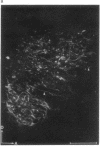Abstract
Pioneer neurons establish preliminary nerve pathways that are followed by later-growing axons. The existence of pioneers and their importance is well documented in invertebrate systems. In mammals, early neuronal development has generally been difficult to study because of the size and complexity of the embryos, and the lack of adequate markers. Here we look at the time of earliest axonal outgrowth in the mouse embryo by using specific monoclonal antibodies to stain wholemount preparations. During the period of formation and closure of the neuropore beginning at embryonic day 8.5, we can follow the earliest trigeminal sensory neurons extending axons along stereotyped pathways. In the trigeminal ganglion, an early wave of neurogenesis gives rise to a small number of neurons whose axons pioneer the different trigeminal tracts in the periphery. After a brief pause (12 hr), these primary axons branch out to innervate individual targets. Emerging a day later, secondary fibers extend along the pioneers. By contrast, in the central nervous system, neurons of the mesencephalic trigeminal nucleus extend toward the rhombencephalon independently, ignoring preexisting fibers. These results show the existence of an early set of axonal tracts in the mouse peripheral nervous system that may be used for the guidance of later-differentiating neurons.
Full text
PDF




Images in this article
Selected References
These references are in PubMed. This may not be the complete list of references from this article.
- Altman J., Bayer S. A. Development of the cranial nerve ganglia and related nuclei in the rat. Adv Anat Embryol Cell Biol. 1982;74:1–90. doi: 10.1007/978-3-642-68479-1. [DOI] [PubMed] [Google Scholar]
- Bate C. M. Pioneer neurones in an insect embryo. Nature. 1976 Mar 4;260(5546):54–56. doi: 10.1038/260054a0. [DOI] [PubMed] [Google Scholar]
- Chan W. Y., Tam P. P. A morphological and experimental study of the mesencephalic neural crest cells in the mouse embryo using wheat germ agglutinin-gold conjugate as the cell marker. Development. 1988 Feb;102(2):427–442. doi: 10.1242/dev.102.2.427. [DOI] [PubMed] [Google Scholar]
- Covell D. A., Jr, Noden D. M. Embryonic development of the chick primary trigeminal sensory-motor complex. J Comp Neurol. 1989 Aug 22;286(4):488–503. doi: 10.1002/cne.902860407. [DOI] [PubMed] [Google Scholar]
- Davies A. M. The growth rate of sensory nerve fibres in the mammalian embryo. Development. 1987 Jun;100(2):307–311. doi: 10.1242/dev.100.2.307. [DOI] [PubMed] [Google Scholar]
- Davies A., Lumsden A. Relation of target encounter and neuronal death to nerve growth factor responsiveness in the developing mouse trigeminal ganglion. J Comp Neurol. 1984 Feb 10;223(1):124–137. doi: 10.1002/cne.902230110. [DOI] [PubMed] [Google Scholar]
- Dodd J., Jessell T. M. Axon guidance and the patterning of neuronal projections in vertebrates. Science. 1988 Nov 4;242(4879):692–699. doi: 10.1126/science.3055291. [DOI] [PubMed] [Google Scholar]
- Ghysen A. Sensory neurones recognise defined pathways in Drosophila central nervous system. Nature. 1978 Aug 31;274(5674):864–872. doi: 10.1038/274869a0. [DOI] [PubMed] [Google Scholar]
- Klose M., Bentley D. Transient pioneer neurons are essential for formation of an embryonic peripheral nerve. Science. 1989 Sep 1;245(4921):982–984. doi: 10.1126/science.2772651. [DOI] [PubMed] [Google Scholar]
- Lance-Jones C., Landmesser L. Pathway selection by chick lumbosacral motoneurons during normal development. Proc R Soc Lond B Biol Sci. 1981 Dec 9;214(1194):1–18. doi: 10.1098/rspb.1981.0079. [DOI] [PubMed] [Google Scholar]
- Lumsden A. G., Davies A. M. Chemotropic effect of specific target epithelium in the developing mammalian nervous system. Nature. 1986 Oct 9;323(6088):538–539. doi: 10.1038/323538a0. [DOI] [PubMed] [Google Scholar]
- Lumsden A. G., Davies A. M. Earliest sensory nerve fibres are guided to peripheral targets by attractants other than nerve growth factor. Nature. 1983 Dec 22;306(5945):786–788. doi: 10.1038/306786a0. [DOI] [PubMed] [Google Scholar]
- McConnell S. K., Ghosh A., Shatz C. J. Subplate neurons pioneer the first axon pathway from the cerebral cortex. Science. 1989 Sep 1;245(4921):978–982. doi: 10.1126/science.2475909. [DOI] [PubMed] [Google Scholar]
- Moody S. A., Quigg M. S., Frankfurter A. Development of the peripheral trigeminal system in the chick revealed by an isotype-specific anti-beta-tubulin monoclonal antibody. J Comp Neurol. 1989 Jan 22;279(4):567–580. doi: 10.1002/cne.902790406. [DOI] [PubMed] [Google Scholar]
- Narayanan C. H., Narayanan Y. Determination of the embryonic origin of the mesencephalic nucleus of the trigeminal nerve in birds. J Embryol Exp Morphol. 1978 Feb;43:85–105. [PubMed] [Google Scholar]
- Raper J. A., Bastiani M. J., Goodman C. S. Pathfinding by neuronal growth cones in grasshopper embryos. IV. The effects of ablating the A and P axons upon the behavior of the G growth cone. J Neurosci. 1984 Sep;4(9):2329–2345. doi: 10.1523/JNEUROSCI.04-09-02329.1984. [DOI] [PMC free article] [PubMed] [Google Scholar]
- Stainier D. Y., Gilbert W. The monoclonal antibody B30 recognizes a specific neuronal cell surface antigen in the developing mesencephalic trigeminal nucleus of the mouse. J Neurosci. 1989 Jul;9(7):2468–2485. doi: 10.1523/JNEUROSCI.09-07-02468.1989. [DOI] [PMC free article] [PubMed] [Google Scholar]
- Tessier-Lavigne M., Placzek M., Lumsden A. G., Dodd J., Jessell T. M. Chemotropic guidance of developing axons in the mammalian central nervous system. Nature. 1988 Dec 22;336(6201):775–778. doi: 10.1038/336775a0. [DOI] [PubMed] [Google Scholar]
- Verwoerd C. D., van Oostrom C. G. Cephalic neural crest and placodes. Adv Anat Embryol Cell Biol. 1979;58:1–75. [PubMed] [Google Scholar]







